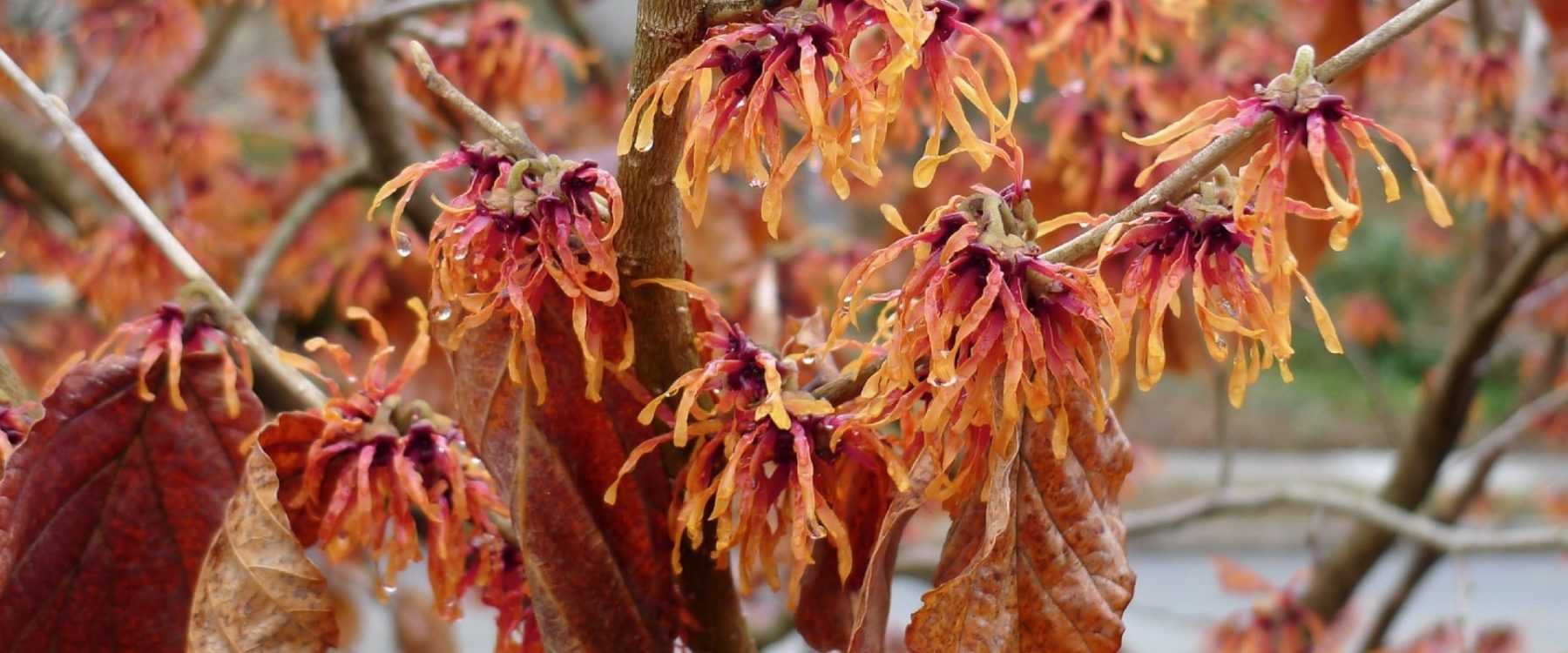
Witch Hazel: Planting, Growing, Care and Companion Planting
Contents
The Witch Hazel in a Few Words
- Witch Hazel is one of the few shrubs that blooms in the heart of winter.
- Its astonishing, spider-like golden yellow or red flowers are highly fragrant.
- Its foliage, with spicy hues, sets the garden ablaze in autumn.
- Easy to maintain and grow, it is resistant to cold and diseases, requiring little attention.
- Compact in size when mature and slow-growing, this elegant shrub finds its place in any garden.
Our expert's word
Elegant and mysterious, long known as “Witch Hazel”, Hamamelis is the must-have ornamental shrub for winter. Its delightfully fragrant blooms and fiery autumn foliage bring life to gardens dormant from the cold, creating an extraordinary display. Its modest mature size, relatively slow growth, and tolerance to polluted air make it an ideal choice for small urban gardens.
While Hamamelis, used in homeopathy and herbal medicine, is renowned for its beneficial properties, this small winter-flowering shrub remains relatively unknown to amateur gardeners. Yet, alongside Daphne and Sarcococca, it is one of the few fragrant shrubs in winter.
The spider-like, intoxicatingly scented flowers of Hamamelis are remarkable, especially as they appear in the heart of winter when the garden is at rest and often bare. They resemble golden-yellow, garnet, or coppery-orange spiders, blooming on bare branches. You can create spectacular winter bouquets with its flowering stems.
Its deciduous foliage also ensures a spectacular show in autumn, turning gold, copper, and red—warm hues that set the garden ablaze. Its spreading silhouette creates beautiful focal points in borders. It works well as a standalone feature in an open space, against a backdrop of evergreen foliage, but always near the house to enjoy its fragrance.
Hardy and low-maintenance, Hamamelis thrives in sun or partial shade and requires little attention. This shrub prefers acidic soil, making it an easy companion for winter-flowering ericaceous plants like Camellias, Azaleas, dwarf Rhododendrons, Sarcococcas, or Daphnes.
Discover this unique little tree that brings precious light, fragrance, and mystery to the heart of winter.
Botany
Botanical data
- Latin name Hamamelis
- Family Hamamelidaceae
- Common name Witch Hazel
- Flowering October to March
- Height 2 to 5 metres
- Sun exposure sun, partial shade
- Soil type acidic (heathland soil) to neutral
- Hardiness below -20°C, -35°C for Hamamelis virginiana
The Hamamelis genus comprises five or six species of deciduous shrubs native to the Far East or North America.
It gives its name to the Hamamelidaceae family, which includes 23 genera and around a hundred species, among which are ornamental plants such as Liquidambar, Persian Parrotia or Corylopsis, all characterised by splendid autumn foliage. It is also called ‘Witch Hazel’ or sometimes ‘Golden Spider Tree’ due to its hazel-like leaves and its strange spider-like flowers that brave snow and ice.
In the wild, Witch Hazel grows in wooded areas or forest edges. It is sometimes found near water when the soil is sufficiently drained. Slow-growing, Witch Hazel is a shrub that will not exceed 4-5 metres (6 at most) in height and spread when mature (after 20 years in open ground). Those expecting a specimen of impressive stature will need to be patient for a few years!
Its modest mature size makes it valuable in a small garden, although it tends to gain some volume with age, with its gracefully spreading branches.
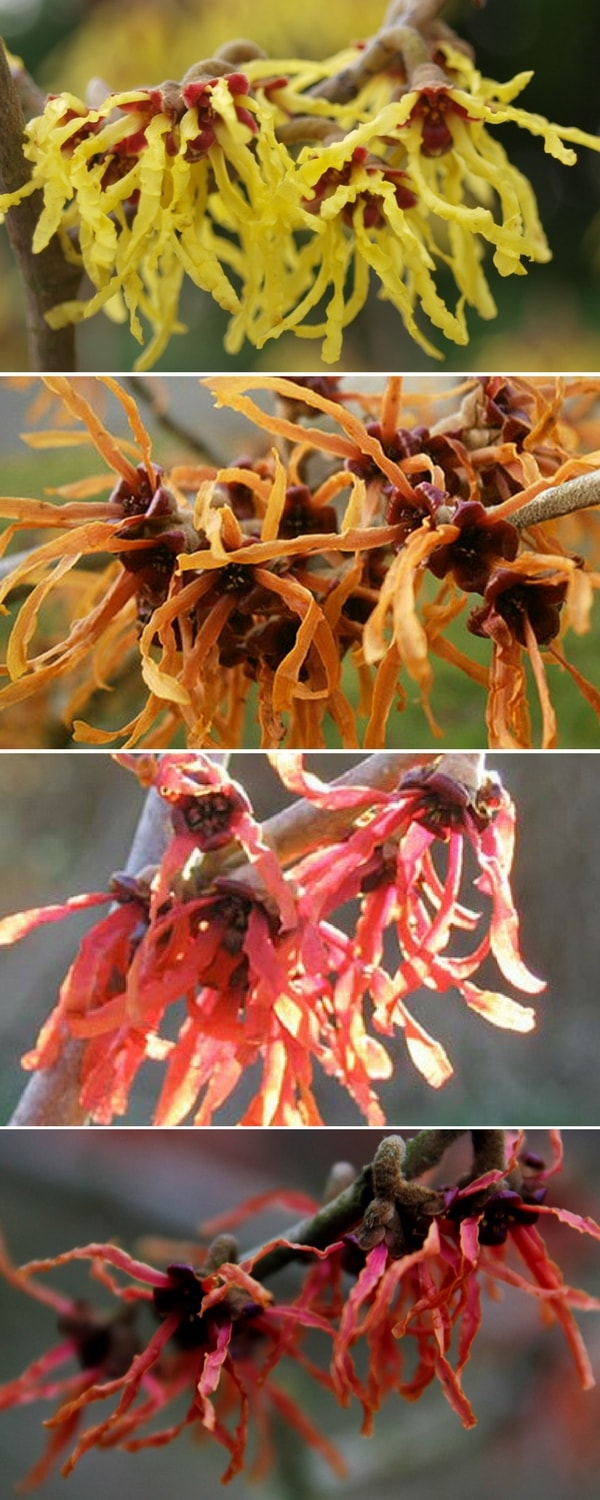
Witch Hazel: a superb palette of colours
Witch Hazel has an attractive upright habit, sometimes rounded and spreading as wide as it is tall, with ascending branches.
Some varieties, such as Hamamelis (x) intermedia ‘Feuerzauber’, have a flared silhouette in their youth, becoming very wide-spreading, resembling a large cup shape when mature.
Ornamental, this shrub will surprise you with its unusual flowers. Fragrant, yellow, coppery orange or red, they bloom, depending on the species, from October to March, before the leaves appear.
The “Witch Hazel” flowers on wood at least one year old. Thread-like, almost crumpled and claw-like, the flowers that adorn the bare branches resemble spiders, hence the poetic name “Golden Spider Tree”, or evoke witch’s fingers. Their fragility is only apparent, as they are very frost-tolerant and can withstand complete freezing. The cold even intensifies the flowering. Composed of 4 strap-shaped petals, sometimes twisted, 1 to 2 cm long, they are grouped in dense clusters like pom-poms. They emit an intoxicating fragrance of hyacinth, narcissus, lemon, honey or even tea. Although quite small (2 to 3 cm), their abundance, flamboyant hues and powerful fragrance warm up winter.
The foliage, deciduous, is another asset of Witch Hazel. Bright green or purple in spring, then lemon turning to bronze-green in summer, the leaves take on shades of yellow, cinnamon orange, brick, bright red or copper in autumn, filling the garden with warm, spicy colours as the days shorten.
Its broad, oval, toothed or scalloped leaves resemble those of hazel, with prominent parallel veins and a slightly crumpled appearance, sometimes slightly velvety underneath. They measure 6 to 15 cm long, depending on the species.
The capsule fruits contain 2 black seeds that reach maturity at the time of the next flowering. The capsules may persist for several years on the branches after releasing their seeds. Note that only the seeds of Hamamelis virginiana are oily and edible.
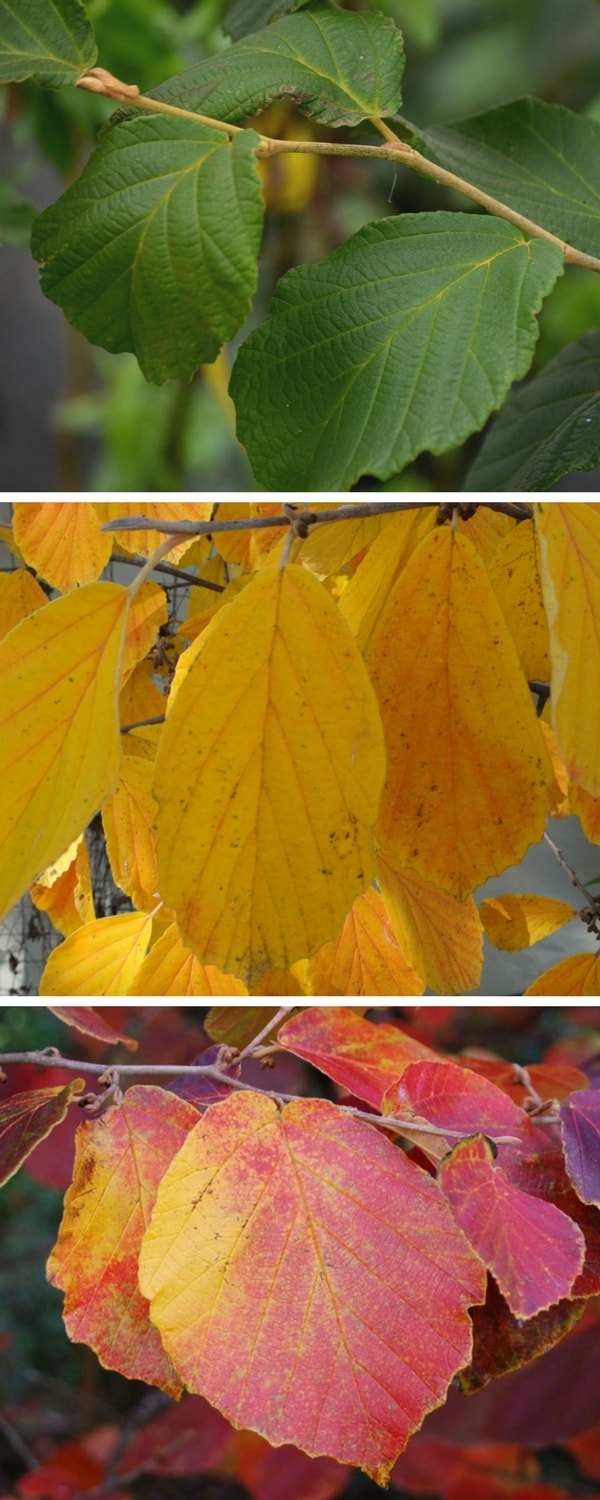
Foliage of Witch Hazels ‘Diane’,
‘Arnold Promise’
(autumn)
and ‘Ruby Glow’ (autumn)
Easy to grow, Witch Hazel should be planted in rich, moist but well-drained and preferably acidic soil. Pure heathland soil is a little too poor and should be enriched with compost to ensure vigorous growth. This shrub dislikes chalky soils (some species like Hamamelis mollis are more tolerant). They are, however, particularly resistant to pollution, making them well-suited to the urban atmosphere of city gardens.
Witch Hazel loves sun, especially in winter, but dislikes it if too scorching in summer. Prefer cool locations, or with “cooling” shade provided in the afternoon in summer by a hedge or wall. A clearing or lightly shaded position sheltered from cold, drying winds will protect its flowering.
Perfectly hardy, it can withstand very low temperatures of -20°C (down to -35°C for H. virginiana). This excellent hardiness ensures a long life in all regions. However, it should be spared from Mediterranean climates, which are a little too hot and dry in summer.
Mysterious, Witch Hazel has long been nicknamed “Witch Hazel”. The English still call it that today. A linguistic shift, as it originally had nothing to do with witches but with water diviners: its flexible branches were used as divining rods by Native Americans. The leaves and bark have astringent properties known to the Virginia Indians for centuries and are used in herbal medicine. Witch hazel water, found in many cosmetics, has soothing properties for skin inflammations.
Species and main varieties
Among the varieties mainly cultivated in gardens, there are five species of Witch Hazel: three native to North America (H. ovalis, H. virginiana which flowers in autumn, H. vernalis), and two of Asian origin, from Japan (H. japonica) and China (H. mollis).
The name Hamamelis x intermedia encompasses the group of cultivars resulting from crosses between H. japonica and H. mollis. These are the most common specimens. They are cultivated for their multiple colours ranging from yellow to red, and their generally larger flowers than those of their parents. The main selection criteria are flowering time and flower colour.
- Hamamelis x intermedia: The fragrant flowers, yellow, dark red or orange, with crumpled petals, bloom from November to March. The cross between the two Asian species has given rise to a large number of varieties, with more or less fragrant flowers, dark red in ‘Diane’, coppery orange in ‘Jelena’, bright yellow in ‘Advent‘, pale yellow in ‘Moonlight’ or lemon yellow tinged with purple in ‘Pallida’, which has the largest flowers, highly prized for their strong honey scent. ‘Ruby Glow’ bears coppery red flowers, and its foliage is narrower than that of other cultivars. In autumn, the foliage of cultivars such as ‘Diane’ and ‘Arnold Promise’ takes on opulent shades of coppery purple-red, while ‘Feuerzauber’ turns orange.
- Hamamelis virginiana: Also called “witch hazel”, this is the largest and most vigorous of the Witch Hazels, reaching up to 5 metres in height at maturity, and also the earliest to flower. Its lemon-yellow, lightly scented flowers begin to bloom as early as October, when the foliage turns orange and gold. The extract from this plant is used in cosmetics.
- Hamamelis japonica: In our latitudes, this shrub with a spreading habit will not exceed 3 to 4 metres in height. Its fragrant, pale yellow flowers, with corkscrew petals, bloom in very large numbers from January to March. Its oval leaves turn yellow in autumn. ‘Zuccariniana’ bears an abundance of small pale lemon-yellow flowers with a lemony scent, appearing late in February-March. ‘Sulphurea’ stands out for its profusion of pale sulphur-yellow flowers from January to late February.
- Hamamelis mollis: This open, airy shrub offers highly fragrant golden-yellow flowers in late February. Its autumn foliage turns yellow. ‘Brevipetala’ has shorter, straight, orange-bronze-yellow petals, and ‘Goldcrest’ features small flowers with red-tinged bases.
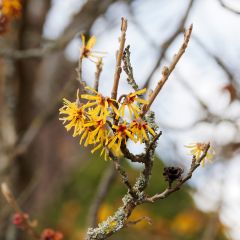
Hamamelis mollis Pallida - Witch Hazel
- Height at maturity 3 m
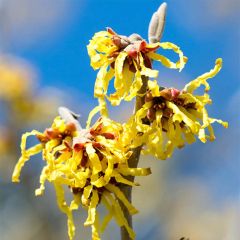
Hamamelis intermedia Arnold Promise - Witch Hazel
- Flowering time February, March
- Height at maturity 4 m
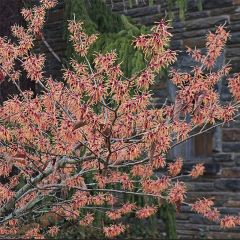
Hamamelis intermedia Feuerzauber - Witch Hazel
- Flowering time March, April
- Height at maturity 3,50 m
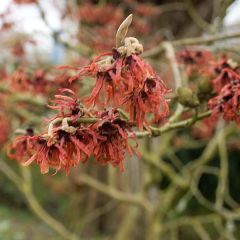
Hamamelis intermedia Ruby Glow - Witch Hazel
- Flowering time February, March
- Height at maturity 2 m
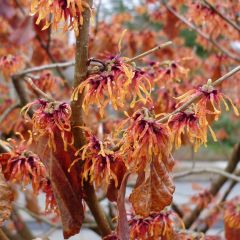
Hamamelis intermedia Jelena - Witch Hazel
- Flowering time February, March
- Height at maturity 4 m
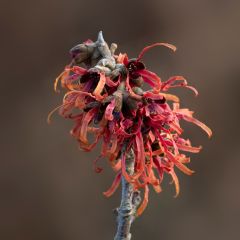
Hamamelis intermedia Diane - Witch Hazel
- Height at maturity 3,50 m

Hamamelis intermedia Ruby Glow - Witch Hazel
- Flowering time February, March
- Height at maturity 2 m
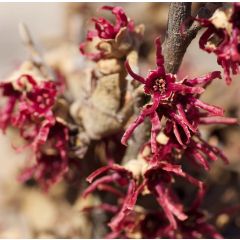
Hamamelis vernalis Amethyst - Witch Hazel
- Flowering time March, April
- Height at maturity 2,50 m

Hamamelis intermedia Feuerzauber - Witch Hazel
- Flowering time March, April
- Height at maturity 3,50 m
- Hamamelis (x) intermedia ‘Primavera’, with early yellow flowers but no fragrance—the only one!
- Hamamelis ‘Westerstede’, with abundant, rather late golden-yellow flowers and a subtle fragrance.
- Hamamelis mollis ‘Brevipetala’, for its clusters of golden-yellow flowers with short petals—an additional oddity for this hybrid!
- Hamamelis (x) intermedia ‘Moonlight’, for its pale yellow flowers speckled with crimson at the base.
- Hamamelis (x) intermedia ‘Orange Beauty’, for its incredible long-lasting blooms in bright yellow washed with orange and crimson.
Discover other Hamamelis - Witch-hazel
Planting
Where to plant Witch Hazel?
It can be grown throughout France, except in Mediterranean climates which are too hot and dry in summer. Highly hardy, it can withstand very low temperatures of -20°C, ensuring perfect hardiness in all regions. Its flowers, despite their apparent fragility, are frost-resistant.
It’s best to avoid windy spots which could dry it out and damage its flowers. It thrives in full sun (if not too scorching) or partial shade in a rather humid environment. Too much shade would result in a slightly less showy bloom. In winter, it needs maximum sunlight to flower abundantly and display beautiful autumn colours.
It prefers slightly acidic, moist, well-drained soil. It dislikes lime and should be grown in ericaceous compost or non-calcareous soil enriched with potting mix. If the foliage yellows and flowering becomes sparse, the soil is too alkaline for its liking. Transplant it, adding ericaceous compost and leaf mould.
Its elegant silhouette shouldn’t be hidden: it needs its own space and is ideally planted as a standalone specimen in an open spot, visible from the house. It makes a lovely centrepiece in borders, standing out against a dark backdrop of evergreen foliage and creating a striking focal point.
You can also plant it in groups of 3 or 5 under large deciduous trees—on frosty mornings, they’ll put on a magical display.
Its slow growth allows for container cultivation while still young. This way, you can enjoy its stunning colours and fragrance on the patio or near entrances.
When to plant?
Witch Hazel is best planted in autumn to encourage root establishment before winter. If tempted by one in bloom, wait until flowering finishes before planting.
If bought potted, you can plant it outside of autumn, avoiding frost or extreme heat. If eager to admire it, avoid very young plants—growth is slow, and the shrub may take years to reach full splendour.
How to plant?
Dig a wide hole and mix sand with ericaceous compost or peat if the soil is alkaline.
Maintenance and Pruning
Maintenance is easy: witch hazel is a shrub that is virtually unaffected by most diseases as well as insect or pest attacks. However, it can be affected by coral spot disease and honey fungus.
To combat coral spot: remove and burn any branches showing orange pustules and apply a sealant and fungicide if necessary.
Honey fungus is a fungus encouraged by excess moisture that enters through the roots and rapidly destroys the plant. Removing the plant and replacing the surrounding soil is then recommended.
Pruning is not necessary, except to reshape the silhouette after flowering, which becomes more defined with age.
If growing witch hazel in a pot:
You can keep a witch hazel in a container for 5–6 years. You’ll enjoy the beauty of its foliage, but flowering will remain limited. Remember to fertilise once a year and water during periods of intense heat or prolonged drought.
Propagation
Witch Hazel is a difficult plant to propagate. Seed germination is very slow, cuttings are unreliable, which is why most commercially available plants are obtained by grafting. Grafted Witch Hazels are sold at an advanced age, as their growth is slow.
Ingrid tells you more in How to Take Witch Hazel Cuttings in 5 Steps?
Companion planting
A winter garden essential, the Witch Hazel is indispensable for bringing life to the garden in autumn and winter. To fully enjoy its beauty and fragrance, plant it as a standalone feature near the house in a pot or against a backdrop of evergreen foliage composed of conifers, shrubs with persistent leaves, or ornamental grasses, which will highlight the delicate beauty of its flowers. It can be paired with spring-flowering shrubs like Forsythia, which will take over the floral display in the garden.
As Witch Hazel thrives in acidic soil, it pairs beautifully with ericaceous plants that have evergreen foliage and winter blooms, such as Camellias, Azaleas, Dwarf Rhododendrons, Sarcococca, or Daphnes. It can also be planted in groups of three or five for a truly enchanting mass effect.
For a colourful winter garden, why not pair Witch Hazel (‘Jelena’) with the stunning Edgeworthia chrysantha (Paper Bush), one or more ornamental fruit shrubs like Crabapple, or some Dogwoods with colourful stems:
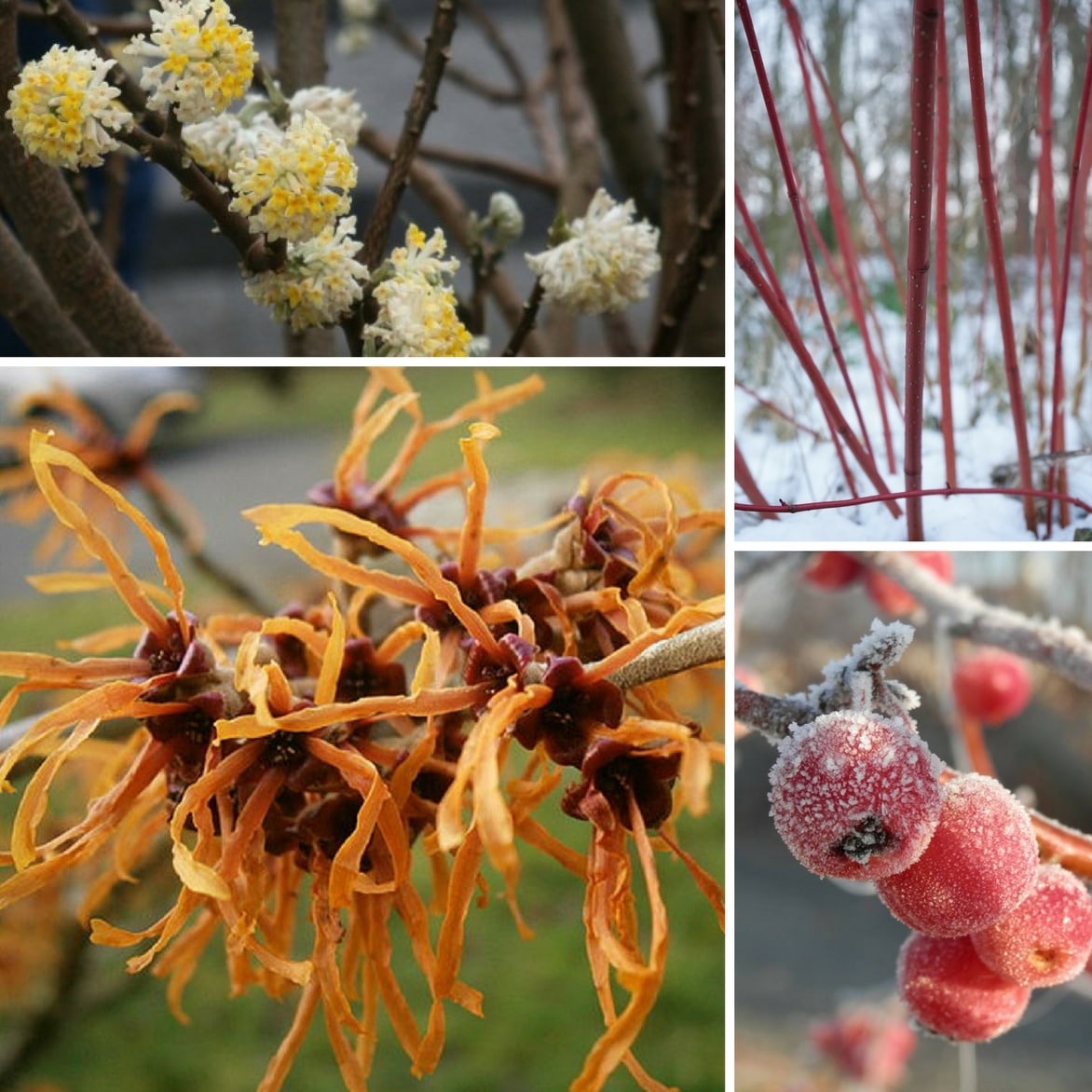
A vibrant winter garden
In a large pot or container, it can be paired with Holly, a rock garden conifer, or Spindle.
The base of the shrub can also be dressed with Winter Heathers, Hellebores, or bulbs to complement the foliage in autumn and spring when the Witch Hazel appears bare—its flowering finished and its young leaves yet to emerge.
Useful resources
- The most beautiful witch hazels are here!
- The Kalmthout Arboretum website beautifully showcases the Hamamelis genus
- Our expert Pierre shares on the Promesses de fleurs blog an inspiring walk through Kalmthout Arboretum
- Discover on our blog: the most beautiful winter blooms
- Our 7 ideas for pairing Witch Hazels
- Our advice sheets: Hamamelis, the most beautiful varieties; Choosing a Witch Hazel; 7 yellow-flowered Witch Hazels for a flowery winter; 4 red-flowered Witch Hazels for a blazing winter garden
- Watch Olivier’s video about Witch Hazel
- Discover How to make Witch Hazel tea?
- Our advice: How to prune Witch Hazel?
- Subscribe!
- Contents

































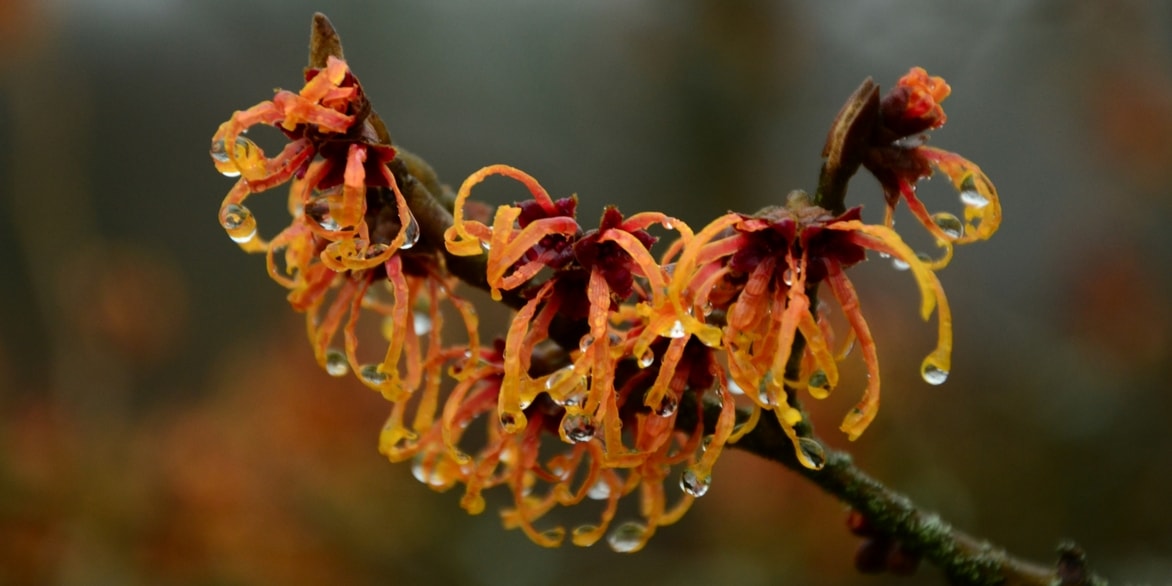


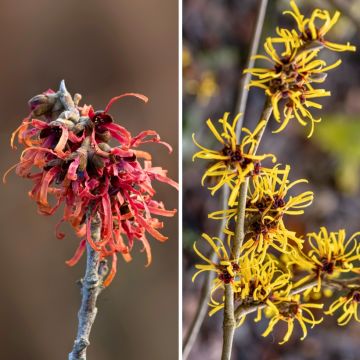



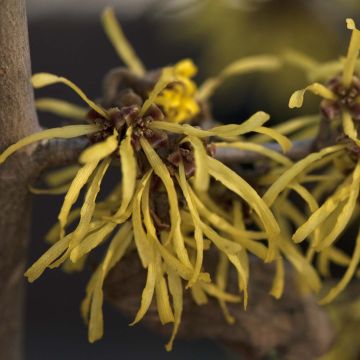

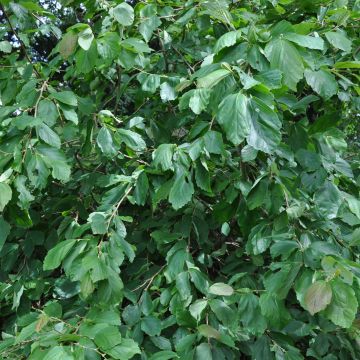

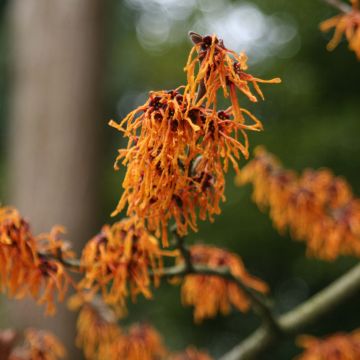
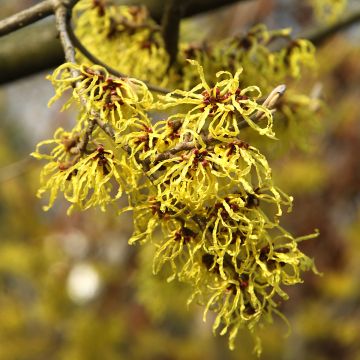
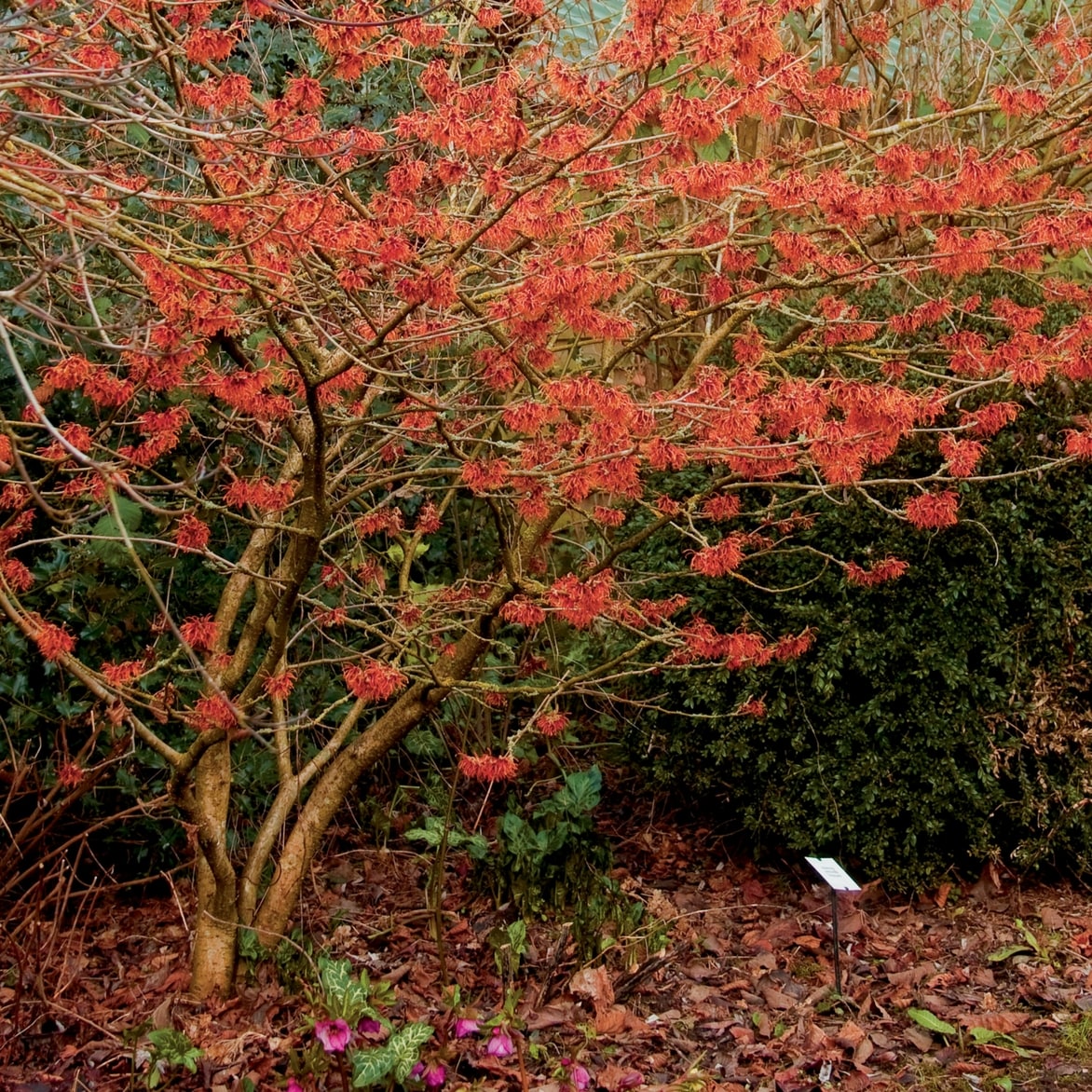
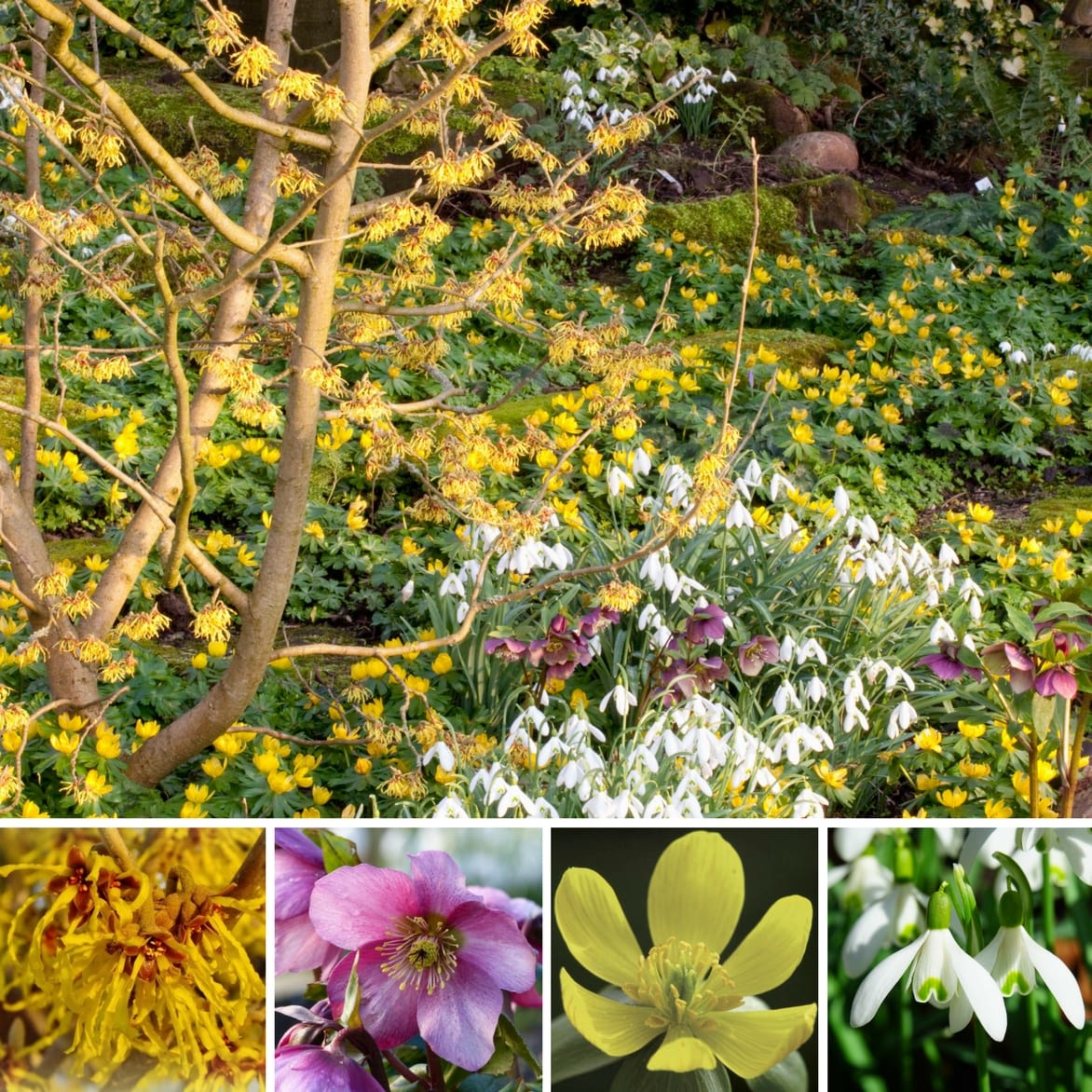
Comments